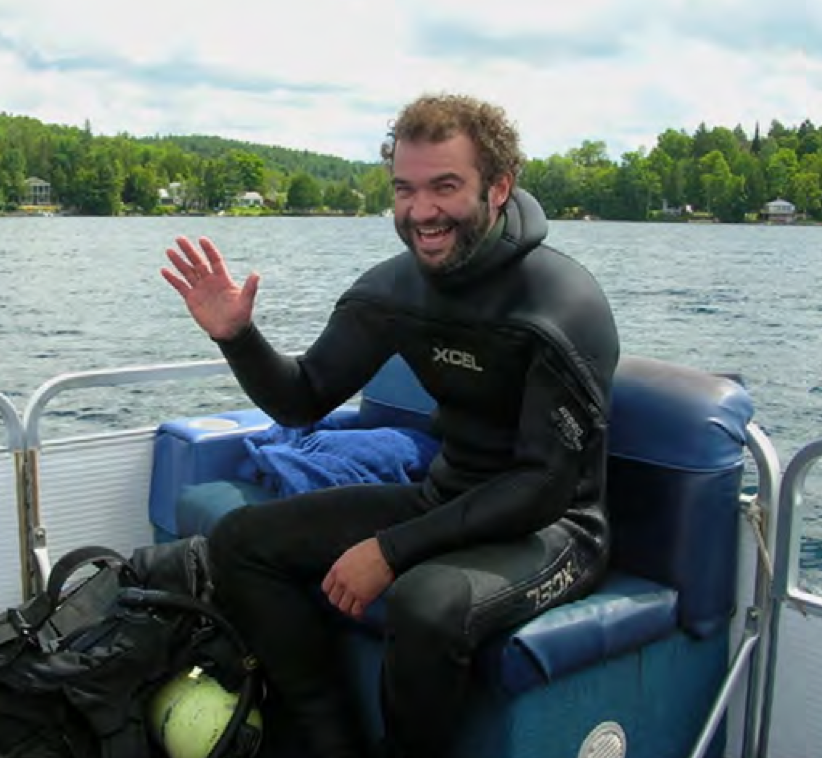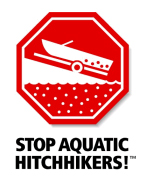Meet Swampguana!
By Tracey Shadday, FOVLAP Auxiliary Board Member
If you’ve ever seen a boat displaying a red flag with a diagonal white stripe on a Vermont lake such as Lake Willoughby, Salem Lake or Shadow Lake, you may have wondered about the flag’s purpose. This flag, pictured at right, signals that a SCUBA diver or snorkeler is in the wa- ter. For the lakes mentioned - as well as others in the Northeast—this could be a sign of important, yet tedious work below the lake’s surface to remove the aquatic inva- sive plant, Eurasian watermilfoil.

Rob Patton, known affectionately by many as “Swampguana,” has managed Eurasian watermilfoil in Northeast Kingdom watermilfoil-infected lakes for years. Swampguana began his SCUBA diving career in college. He started as a summer boat tender on Lake Willoughby for a commercial diving company hired to remove Eurasian wa- termilfoil. As tender, he assisted divers and watched over their safety, ensured boat organization and maintenance, checked all equipment regularly and properly disposed of plants removed. Later, Rob became an open-water certi- fied SCUBA diver and continued his water work with the commercial outfit and on his own but now beneath the water as a SCUBA diver.
Swampguana is passionate about the environment and loves the world Vermont lakes and ponds offer to those willing to venture beneath their surfaces. Rob is al- ways careful to protect the natural species living there whenever he works or recreates on or below the surface. In addition to Eurasian watermilfoil, Rob has seen and re- moved a lot of garbage on his many underwater excur- sions, from car batteries and bottles to a drowned drone.
When asked, Rob will tell you removal of Eurasian wa- termilfoil must be done carefully to ensure thorough re- moval of the plants’ roots and stems, and no stem frag- ments float away. One small piece of a watermilfoil stem can produce a new plant and, could lead to a new infesta- tion wherever it lands. Rob emphasizes lake water clarity, which depends upon each lake and weather conditions, is a critical factor in effective control. A diver must be able to see the plants they need to harvest.
Rob is experienced with several known watermilfoil management methods: surveying, hand pulling, use of a diver operated suction harvester, benthic mats, and proper plant disposal. Hand pulling is the best control tool when a plant population is small or when scattered plants are around a lake; a suction harvester and benthic mats work better for controlling larger patches. A suction har- vester unit allows a diver to suction removed plants up to the water’s surface for collection versus hand pulling, a diver must collect pulled plants into a mesh bag, and when full, transport it to the surface by swimming. To see an underwater video of Swampguana, or Rob Patton, hand pulling watermilfoil, click here. If conditions warrant, the use of a suction harvester can result in 60-70 five-gallon buckets of unwanted watermilfoil in only 4 hours.
Controlling Eurasian watermilfoil is not without costs. SCUBA divers with Eurasian watermilfoil control experi- ence can cost a minimum of $50 per hour. Add a suction harvester boat and crew, and the price jumps to approxi- mately $1,200 per day.
Okay, so you have a control plan for Eurasian water- milfoil but how do you find watermilfoil in a lake or pond? Some groups hire a surveyor; others engage volunteers like Vermont Invasive Patrolers, trained to search for inva- sive aquatic species in Vermont water bodies. Surveyors swim, wade, kayak or canoe in their hunt for Eurasian wa-termilfoil, and track or mark a site for a SCUBA diver like Swampguana to return to manage.
Take Shadow Lake in Glover’s experience. The Shadow Lake Association’s watermilfoil rapid response began in 2011 with the confirmation of Eurasian watermilfoil. Shadow Lake Association member and current FOVLAP board member, Christine Cano volunteered for several years, helping the lake association with their management efforts. Chris spent hundreds of hours researching control methods. As a snorkel volunteer, she methodically surveyed the entire lakeshore, pulling watermilfoil, taking detailed notes, marking and map- ping each site, and coordinating volunteers. This effort ena- bled the Shadow Lake Milfoil Committee, and state and hired divers – in this case, Swampguana – to control under- water sites by either hand pulling or using benthic mats. After the initial six years of battling watermilfoil, successful management was achieved at Shadow Lake. By repeating the seasonal surveying effort with Rob and others, watermil- foil has not been found in Shadow Lake now for three years in a row!
The Shadow Lake watermilfoil story represents what it takes to manage an aquatic invasive plant - and keeps Rob feeling hopeful. Management of aquatic invasive species is a collaborative, on-going, detail-oriented and often expensive effort. Remembering the lesson from other watermilfoil management efforts, a new infestation can reappear any- time, especially if a lake has public access, is critical to suc- cess and means watermilfoil management at Shadow Lake must stay future-directed and is, unfortunately, a never- ending story.

Rob Patton, aka Swampguana, resides in Vermont’s Northeast Kingdom and can be contacted at This email address is being protected from spambots. You need JavaScript enabled to view it. or 802-274-7016.


